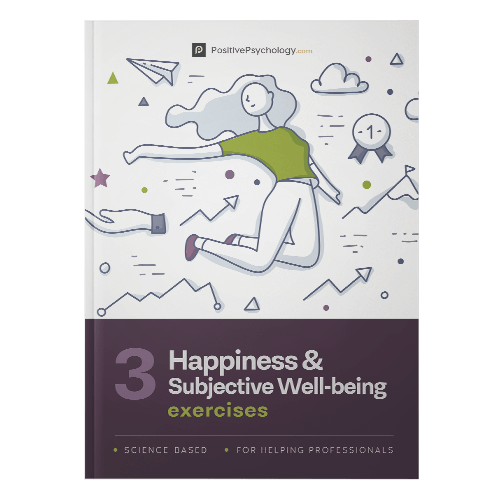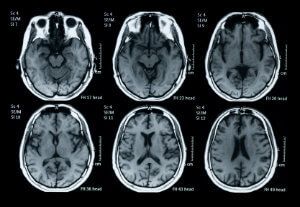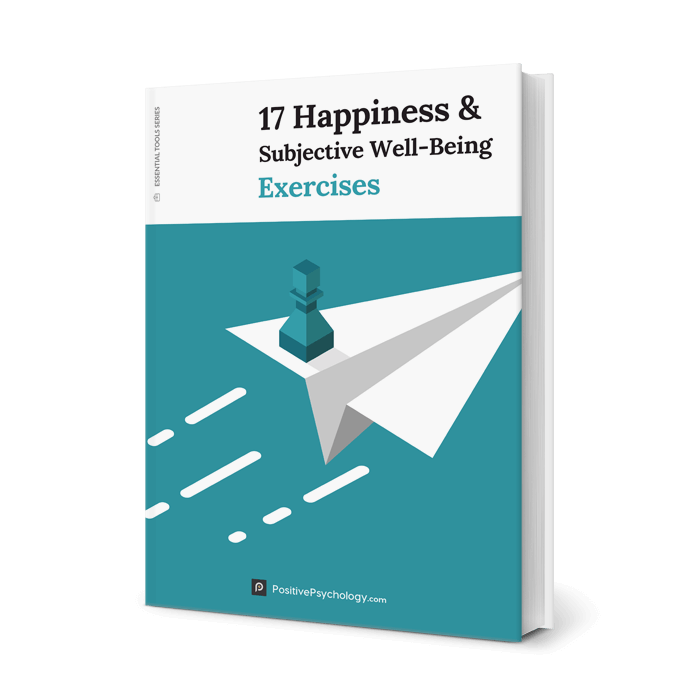The Science of Happiness in Positive Psychology 101
 Happiness has been a human pursuit for as long as we can remember, and positive psychology has taken this concept into the realm of scientific research in hopes of gaining a better understanding of global wellbeing and meaningful living.
Happiness has been a human pursuit for as long as we can remember, and positive psychology has taken this concept into the realm of scientific research in hopes of gaining a better understanding of global wellbeing and meaningful living.
Whether on a global or an individual level, the pursuit of happiness is one that is gaining traction and scientific recognition.
There are many definitions of happiness, and we will also explore those in this article. For now, we invite you to think of a time when you were happy. Were you alone? With others? Inside? Outside.
At the end of this article, revisit that memory. You may have new insight as to what made that moment “happy,” as well as tips to train your brain towards more happiness.
Before you continue, we thought you might like to download our three Happiness & Subjective Wellbeing Exercises for free. These detailed, science-based exercises will help you or your clients identify sources of authentic happiness and strategies to boost wellbeing.
This Article Contains:
- A Definition of Happiness
- A Look at the Science of Happiness
- The Scientific Research on Happiness at Work
- 17 Interesting Facts and Findings
- A Study Showing How Acts of Kindness Make us Happier
- The Global Pursuit of Happiness
- Measures of Happiness
- Four Qualities of Life
- How to Train your Brain for Happiness
- A Take-Home Message
- References
A Definition of Happiness
In general, happiness is understood as the positive emotions we have in regards to the pleasurable activities we take part in through our daily lives.
Pleasure, comfort, gratitude, hope, and inspiration are examples of positive emotions that increase our happiness and move us to flourish. In scientific literature, happiness is referred to as hedonia (Ryan & Deci, 2001), the presence of positive emotions and the absence of negative emotions.
In a more broad understanding, human wellbeing is made up of both hedonic and Eudaimonic principles, the literature on which is vast and describes our personal meaning and purpose in life (Ryan & Deci, 2001).
Research on happiness over the years has found that there are some contributing correlational factors that affect our happiness. These include (Ryan & Deci, 2001):
- Personality Type
- Positive Emotions versus Negative Emotions
- Attitude towards Physical Health
- Social Class and Wealth
- Attachment and Relatedness
- Goals and Self-Efficacy
- Time and Place.
A Look at the Science of Happiness
So what is the “science of happiness?”
This is one of those times when something is exactly what it sounds like – it’s all about the science behinds what happiness is and how to experience it, what happy people do differently, and what we can do to feel happier.
This focus on happiness is new to the field of psychology; for many decades – basically since the foundation of psychology as a science in the mid- to late-1800s – the focus was on the less pleasant in life. The field focused on pathology, on the worst-scenario cases, on what can go wrong in our lives.
Although there was some attention paid to wellbeing, success, and high functioning, the vast majority of funding and research was dedicated to those who were struggling the most: those with severe mental illness, mental disorders, or those who have survived trauma and tragedy.
While there’s certainly nothing wrong with doing what we can to raise up those who are struggling, there was an unfortunate lack of knowledge about what we can do to bring us all up to a higher level of functioning and happiness.
Positive psychology changed all of that. Suddenly, there was space at the table for a focus on the positive in life, for “what thoughts, actions, and behaviors make us more productive at work, happier in our relationships, and more fulfilled at the end of the day” (Happify Daily, n.d.).
The science of happiness has opened our eyes to a plethora of new findings about the sunny side of life.
Current research and studies
For instance, we have learned a lot about what happiness is and what drives us.
Recent studies have shown us that:
- Money can only buy happiness up to about $75,000 – after that, it has no significant effect on our emotional wellbeing (Kahneman & Deaton, 2010).
- Most of our happiness is not determined by our genetics, but by our experiences and our day-to-day lives (Lyubomirsky et al., 2005).
- Trying too hard to find happiness often has the opposite effect and can lead us to be overly selfish (Mauss et al., 2012).
- Pursuing happiness through social means (e.g., spending more time with family and friends) is more likely to be effective than other methods (Rohrer et al., 2018).
- The pursuit of happiness is one place where we should consider ditching the SMART goals; it may be more effective to pursue “vague” happiness goals than more specific ones (Rodas et al., 2018).
- Happiness makes us better citizens – it is a good predictor of civic engagement in the transition to adulthood (Fang et al., 2018).
- Happiness leads to career success, and it doesn’t have to be “natural” happiness – researchers found that “experimentally enhancing” positive emotions also contributed to improved outcomes at work (Walsh et al., 2018).
- There is a linear relationship between religious involvement and happiness. Higher worship service attendance is correlated with more commitment to faith, and commitment to faith is related to greater compassion. Those more compassionate individuals are more likely to provide emotional support to others, and those who provide emotional support to others are more likely to be happy (Krause et al., 2018). It’s a long road, but a direct one!
The Scientific Research on Happiness at Work
There’s been a ton of research on the effects of happiness in the workplace. Much of this is driven by companies who want to find a way to improve productivity, attract new talent, and get a dose of good publicity, all at the same time. After all, who wouldn’t want to do business with and/or work for a company full of happy employees?
Although the jury is still out on exactly how happy employees “should” be for maximum productivity, efficiency, and health, we have learned a few things about the effects of a happy workforce:
- People who are happy with their jobs are less likely to leave their jobs, less likely to be absent, and less likely to engage in counterproductive behaviors at work.
- People who are happy with their jobs are more likely to engage in behavior that contributes to a happy and productive organization, more likely to be physically healthy, and more likely to be mentally healthy.
- Happiness and job performance are related—and the relationship likely works in both directions (e.g., happy people do a better job and people who do a good job are more likely to be happy).
- Unit- or team-level happiness is also linked to positive outcomes, including higher customer satisfaction, profit, productivity, employee turnover, and a safer work environment.
- In general, a happier organization is a more productive and successful organization (Fisher, 2010).
To sum up the findings we have so far, it’s easy to see that happiness at work does matter – for individuals, for teams, and for organizations overall. We don’t have all the answers about exactly how the relationship between happiness and productivity works, but we know that there is a relationship there.
Lately, many human resources managers, executives, and other organizational leaders have decided that knowing there’s a relationship is good enough evidence to establish happiness-boosting practices at work, which means that we have a lot of opportunities to see the impact of greater happiness at work in the future.
17 Interesting Facts and Findings
Research in this field is booming, and new findings are coming out all the time. Here are a few of the most interesting facts and findings so far:
- Happiness is linked to lower heart rate and blood pressure, as well as healthier heart rate variability.
- Happiness can also act as a barrier between you and germs – happier people are less likely to get sick.
- People who are happier enjoy greater protection against stress and release less of the stress hormone cortisol.
- Happy people tend to experience fewer aches and pains, including dizziness, muscle strain, and heartburn.
- Happiness acts as a protective factor against disease and disability (in general, of course).
- Those who are happiest tend to live significantly longer than those who are not.
- Happiness boosts our immune system, which can help us fight and fend off the common cold.
- Happy people tend to make others happier as well, and vice versa – those who do good, feel good!
- A portion of our happiness is determined by our genetics (but there’s still plenty of room for attitude adjustments and happiness-boosting exercises!).
- Smelling floral scents like roses can make us happier.
- Those who are paid by the hour may be happier than those on salary (however, these findings are limited, so take them with a grain of salt!).
- Relationships are much more conducive to a happy life than money.
- Happier people tend to wear bright colors; it’s not certain which way the relationship works, but it can’t hurt to throw on some brighter hues once in a while—just in case!
- Happiness can help people cope with arthritis and chronic pain better.
- Being outdoors – especially near the water – can make us happier.
- The holidays can be a stressful time, even for the happiest among us – an estimated 44% of women and 31% of men get the “holiday blues.”
- Happiness is contagious! When we spend time around happy people, we’re likely to get a boost of happiness as well.
Newman (2015) is the source for the first six facts and findings, and Florentine (2016) for the latter 11.
A Study Showing How Acts of Kindness Make us Happier

Feeling blue? Treat yourself to a decadent dessert.
Feeling frustrated after an argument with a friend? Skip your workout and have an extra scoop of ice cream.
The message is clear: If you want to feel happy, you should focus on your own wishes and desires. Yet this is not the advice that many people grew up hearing. Indeed, most of the world’s religions (and grandmothers everywhere) have long suggested that people should focus on others first and themselves second.
Psychologists refer to such behavior as prosocial behavior and many recent studies have shown that when people have a prosocial focus, doing kind acts for others, their own happiness increases.
But how does prosocial behavior compare to treating yourself in terms of your happiness? And does treating yourself really make you feel happy?
Nelson et al. (2016) presented their research answering these questions.
The Study
Participants were divided into four groups and given new instructions each week for four weeks.
One group was instructed to perform random acts of kindness for themselves (such as going shopping or enjoying a favorite hobby); the second group was instructed to perform acts of kindness for others (such as visiting an elderly relative or helping someone carry groceries); the third group was instructed to perform acts of kindness to improve the world (such as recycling or donating to charity); the fourth group was instructed to keep track of their daily activities.
Each week, the participants reported their activities from the previous week, as well as their experience of positive and negative emotions.
At the beginning, the end, and again two weeks after the four-week period, participants completed a questionnaire to assess their psychological flourishing. As a measure of overall happiness, the questionnaire included questions about psychological, social, and emotional wellbeing.
The Results
The results of the study were striking. Only participants who engaged in prosocial behavior demonstrated improvements in psychological flourishing.
Participants who practiced prosocial behavior demonstrated increases in positive emotions from one week to the next. In turn, these increases in feelings such as happiness, joy, and enjoyment predicted increases in psychological flourishing at the end of the study. In other words, positive emotions appeared to have been a critical ingredient linking prosocial behavior to increases in flourishing.
But what about the people who treated themselves?
They did not show the same increases in positive emotions or psychological flourishing as those who engaged in acts of kindness. In fact, people who treated themselves did not differ in positive emotions, negative emotions, or psychological flourishing over the course of the study compared to those who merely kept track of their daily activities.
This research does not say that we shouldn’t treat ourselves, show ourselves self-love when we need it, or enjoy our relaxation when we have it. However, the results of this study strongly suggest that we are more likely to reach greater levels of happiness when we exhibit prosocial behavior and show others kindness through our actions.
The Global Pursuit of Happiness
In world economic circles, Richard Easterlin investigated the relationship between money and wellbeing.
The Easterlin paradox—”money does not buy happiness” (Mohun, 2012)—sparked a new wave of thinking about wealth and wellbeing.
In 1972, Bhutan chose to pursue a policy of happiness rather than a focus on economic growth tracked via their gross domestic product (GDPP). Subsequently, this little nation has been among the happiest, ranking amongst nations with far superior wealth (Kelly, 2012).
More global organizations and nations are becoming aware and supportive of the importance of happiness in today’s world. This has lead to The United Nations inviting nations to take part in a happiness survey, resulting in the “World Happiness Report,” a basis from which to steer public policy. Learn about the World Happiness Report for 2016.
The United Nations also established World Happiness Day, March 20th, which was the result of efforts of the Bhutan Kingdom and their Gross National Happiness initiative (Helliwell et al., 2013).
Organizations such as the New Economic Foundation are playing an influential role as an economic think tank that focuses on steering economic policy and development for the betterment of human wellbeing.
Ruut Veenhoven, a world authority on the scientific study of happiness, was one of the sources of inspiration for the United Nations General Assembly (2013) adopting happiness measures. Veenhoven is a founding member of the World Database of Happiness, which is a comprehensive scientific repository of happiness measures worldwide.
The objective of this organization is to provide a coordinated collection of data, with common interpretation according to a scientifically validated happiness theory, model, and body of research.
Measures of Happiness
At this point, you might be wondering: Is it possible to measure happiness? Many psychologists have devoted their careers to answering this question and in short, the answer is yes.
Happiness can be measured by these three factors: the presence of positive emotions, the absence of negative emotions, and life satisfaction (Ryan & Deci, 2001). It is a uniquely subjective experience, which means that nobody is better at reporting on someone’s happiness than the individuals themselves.
For this reason scales, self-report measures, and questionnaires are the most common formats for measuring happiness. The most recognized examples are the following:
- The PANAS (Positive Affect and Negative Affect Schedule);
- The SWLS (Satisfaction With Life Scale);
- The SHS (Subjective Happiness Scale)
However, there are many instruments available to measure happiness that have proven reliable and valid over time (Hefferon & Boniwell, 2011).
Four Qualities of Life

Of the four dimensions, satisfaction is our personal subjective measure of happiness as we interpret life as a whole. Veenhoven’s (2010) global research into happiness suggests that happiness is possible for many.
This is an overview of his Four Qualities:
| Outer Qualities | Inner Qualities | |
|---|---|---|
| Life Chances | Liveability of Environment | Life-ability of Individual |
| Life Results | Utility of Life | Satisfaction |
Using Veenhoven’s Four Qualities it is possible to assess the happiness of any country.
Liveability of environment
This dimension includes factors such as law, freedom, schooling, employment, electricity or gas, etc. It is a measurement of how well an environment meets what Maslow proposed as our basic needs (safety, security, shelter, food) (Maslow, 1943).
Life-ability of individuals
The ability of individuals to deal with life is important; both mental and physical health are identified as important factors, together with social values of solidarity, tolerance, and love (Veenhoven, 2010).
Utility of life
In this dimension, Veenhoven (2010) references a higher-order meaning, for example, religious affiliations.
Uchida et al. (2014) found that high levels of national disaster negatively impacted a nation’s level of happiness.
Satisfaction
Happiness is a complex construct that cannot be directly controlled. Through policy and individual and organizational action, one can endeavor to influence and increase happiness (Veenhoven, 2010).
However, happiness is a subjective experience and only once we change the way we perceive the world can we really begin sharing and creating happiness for others.
But is it possible to train yourself to be happier?
The answer is yes!
How to Train Your Brain for Happiness
At birth, our genetics provide us a set point that accounts for some portion of our happiness. Having enough food, shelter, and safety account for another portion.
There’s also quite a bit of happiness that’s entirely up to us (Lyubomirsky et al., 2005).
By training our brain through awareness and exercises to think in a happier, more optimistic, and more resilient way, we can effectively train our brains for happiness.
New discoveries in the field of positive psychology show that physical health, psychological wellbeing, and physiological functioning are all improved by how we learn to “feel good” (Fredrickson, et al., 2000).
What Are The Patterns We Need To “Train Out” of Our Brains?
- Perfectionism – Often confused with conscientiousness, which involves appropriate and tangible expectations, perfectionism involves inappropriate levels of expectations and intangible goals. It often produces problems for adults, adolescents, and children.
- Social comparison – When we compare ourselves to others we often find ourselves lacking. Healthy social comparison is about finding what you admire in others and learning to strive for those qualities. However, the best comparisons we can make are with ourselves. How are you better than you were in the past?
- Materialism – Attaching our happiness to external things and material wealth is dangerous, as we can lose our happiness if our material circumstances change (Carter & Gilovich, 2010).
- Maximizing – Maximizers search for better options even when they are satisfied. This leaves them little time to be present for the good moments in their lives and with very little gratitude (Schwartz et al., 2002).
Misconceptions About Mind Training
Some of the misconceptions about retraining your brain are simply untrue. Here are a few myths that need debunking:
1. We are products of our genetics so we cannot create change in our brains.
Our minds are malleable. Ten years ago we thought brain pathways were set in early childhood. In fact, we now know that there is huge potential for large changes through to your twenties, and neuroplasticity is still changing throughout one’s life.
The myelin sheath that covers your neural pathways gets thicker and stronger the more it is used (think of the plastic protective covering on wires); the more a pathway is used, the stronger the myelin and the faster the neural pathway. Simply put, when you practice feeling grateful, you notice more things to be grateful for.
2. Brain training is brainwashing.
Brainwashing is an involuntary change. If we focus on training our mind to see the glass half full instead of half empty, that is a choice.
3. If we are too happy we run the risk of becoming overly optimistic.
There is no such thing as overly optimistic, and science shows that brain training for positivity includes practices like mindfulness and gratitude. No one has ever overdosed on these habits.
How Is The Brain Wired For Happiness?
Our brains come already designed for happiness. We have caregiving systems in place for eye contact, touch, and vocalizations to let others know we are trustworthy and secure.
Our brains also regulate chemicals like oxytocin.
People who have more oxytocin trust more readily, have increased tendencies towards monogamy, and exhibit more caregiving behavior. These behaviors reduce stress which lowers production of hormones like cortisol and inhibits the cardiovascular response to stress (Kosfeld et al., 2005).
The following TED talk provides an insight into how we can overcome our negative mental patterns:
If happiness has little to do with having too many resources, then it is an inner state that we have the power to cultivate. The above video even offers specific exercises for you to try. Just by doing them, you are actively re-wiring your brain towards calm and happy sensations.
Meanwhile, this TED talk gives a better understanding of how to wire your brain to accept the positivity and happiness in your life:
The negativity bias that Dr. Rick Hanson discusses can help us understand how we can activate and “install” positive thinking as part of our core brain chemistry. If you don’t have a moment to watch either of these videos now, make time for it later—they are rich with relevant data and tips.
A Take-Home Message
Happiness is the overall subjective experience of our positive emotions. There are many factors which influence our happiness, and ongoing research continues to uncover what makes us happiest.
This global pursuit of happiness has resulted in measures such as the World Happiness Report, while the World Happiness Database is working to collaborate and consolidate the existing happiness pursuits of different nations.
We are living in a time when the conditions for happiness are known. This can be disheartening at times when there is much negativity in the world.
There is, however, good news in this situation: neuroplasticity.
The human brain is wired for happiness and positive connections with others. It is actually possible to experience and learn happiness despite what has been genetically hardwired.
In a world where the focus on happiness is growing and the mirror is turning back towards ourselves, the happiness of the world relies on the happiness within each one of us and how we act, share, and voice the importance of happiness for everyone.
What are the steps you are taking to make yourself and others happier? Let us know by leaving a comment below!
We hope you enjoyed reading this article. Don’t forget to download our three Happiness Exercises for free.
- Carter, T. J., & Gilovich, T. (2010). The relative relativity of material and experiential purchases. Journal of Personality and Social Psychology, 98(1), 146.
- Fang, S., Galambos, N. L., Johnson, M. D., & Krahn, H. J. (2018). Happiness is the way: Paths to civic engagement between young adulthood and midlife. International Journal of Behavioral Development, 42(4), 425–433.
- Fisher, C. D. (2010). Happiness at work. International Journal of Management Reviews, 12(4), 384–412.
- Florentine, E. (2016, July 1). 11 Scientific facts about happiness. Bustle. Retrieved from https://www.bustle.com/articles/169675-11-scientific-facts-about-happiness-that-youll-want-to-know.
- Fredrickson, B. L., Mancuso, R. A., Branigan, C., & Tugade, M. M. (2000). The undoing effect of positive emotions. Motivation and Emotion, 24(4), 237–258.
- Happify Daily. (n.d.). What is the science of happiness? Retrieved from https://www.happify.com/hd/what-is-the-science-of-happiness/.
- Hefferon, K., & Boniwell, I. (2011). Positive psychology: Theory, research, and applications. Open University Press.
- Helliwell, J., Layard, R., & Sachs, J. (2013). World happiness report 2013. United Nations.
- Kahneman, D., & Deaton, A. (2010). High income improves evaluation of life but not emotional well-being. Proceeding of the National Academy of Sciences, 107(38), 16489–16493.
- Kelly, A. (2012) Gross national happiness in Bhutan: the big idea from a tiny state that could change the world. The Guardian. Retrieved from: http://www.theguardian.com/world/2012/dec/01/bhutan-wealth-happiness-counts?CMP=share_btn_link
- Kosfeld, M., Heinrichs, M., Zak, P. J., Fischbacher, U., & Fehr, E. (2005). Oxytocin increases trust in humans. Nature, 435(7042), 673–676.
- Krause, N., Ironson, G., & Hill, P. (2018). Religious involvement and happiness: Assessing the mediating role of compassion and helping others. The Journal of Social Psychology, 158(2), 256–270.
- Lyubomirsky, S., Sheldon, K. M., & Schkade, D. (2005). Pursuing happiness: The architecture of sustainable change. Review of General Psychology, 9(2), 111–131.
- Maguire, E., Gadian, D., Johnsrude, I., Good, C., Ashburne, J., Frackowiak, R., & Frith, C. (2000). Navigation-related structural change in the hippocampi of taxi drivers. Proceedings of the National Academy of Sciences, 97(8), 4398-4403.
- Maslow, A. H. (1943). A theory of human motivation. Psychological Review, 50(4), 370.
- Mauss, I. B., Savino, N. S., Anderson, C. L., Weisbuch, M., Tamir, M., & Laudenslager, M. L. (2012). The pursuit of happiness can be lonely. Emotion, 12(5), 908–912.
- Mohun, J. (2012) The economics book. DK.
- Nelson, S. K., Layous, K., Cole, S. W., & Lyubomirsky, S. (2016). Do unto others or treat yourself? The effects of prosocial and self-focused behavior on psychological flourishing. Emotion, 16(6), 850–861.
- Newman, K. M. (2015, July 28). Six ways happiness is good for your health. Greater Good Magazine. Retrieved from https://greatergood.berkeley.edu/article/item/six_ways_happiness_is_good_for_your_health
- Rodas, M. A., Ahluwalia, R., & Olson, N. J. (2018). A path to more enduring happiness: Take a detour from specific emotional goals. Journal of Consumer Psychology, 28(4), 673–681.
- Rohrer, J. M., Richter, D., Brümmer, M., Wagner, G. G., & Schmukle, S. C. (2018). Successfully striving for happiness: Socially engaged pursuits predict increases in life satisfaction. Association for Psychological Science, 29(8), 1291–1298.
- Ryan, R. M., & Deci, E. L. (2001). On happiness and human potentials: A review of research on hedonic and eudaimonic well-being. Annual Reviews Psychology, 52, 141–66.
- Ryff, C. D., & Singer, B. H. (2006). Know Thyself and Become What You Are: A Eudemonic approach to psychological well-being. Journal of Happiness Studies 9:13 -39, 2008.
- Schwartz, B., Ward, A., Monterosso, J., Lyubomirsky, S., White, K., & Lehman, D. R. (2002). Maximizing versus satisficing: Happiness is a matter of choice. Journal of Personality and Social Psychology, 83(5), 1178.
- Shapiro, S. L., Carlson, L. E., Astin, J. A., & Freedman, B. (2006). Mechanisms of mindfulness. Journal of clinical psychology, 62(3), 373-386.
- Sheldon, K. M., & Lyubomirsky, (2006). Achieving Sustainable Gains in Happiness: Change your actions, not your circumstances. Journal of Happiness Studies (2006) 7:55-86.
- Uchida, Y., Takahashi, Y., & Kawahara, K. (2014). Changes in hedonic and eudaimonic well-being after a severe nationwide disaster: The case of the great east Japan earthquake. Journal of Happiness Studies, 15, 207–221.
- United Nations General Assembly. (2013). Happiness: towards a holistic approach to development. Sixty-seventh session Agenda item 14. Retrieved from http://www.un.org/ga/search/view_doc.asp?symbol=A/67/697
- Veenhoven, R. (2000). The four qualities of life: Ordering concepts and measures of the good life. Journal of Happiness Studies, 1, 1–39.
- Veenhoven, R. (2010). Greater happiness for a greater number: Is that possible and desirable? Journal of Happiness Studies, 11, 605–629.
- Walsh, L. C., Boehm, J. K., & Lyubomirsky, S. (2018). Does happiness promote career success? Revisiting the evidence. Journal of Career Assessment, 26(2), 199–219.
Let us know your thoughts
Read other articles by their category
- Body & Brain (49)
- Coaching & Application (57)
- Compassion (26)
- Counseling (51)
- Emotional Intelligence (24)
- Gratitude (18)
- Grief & Bereavement (21)
- Happiness & SWB (40)
- Meaning & Values (26)
- Meditation (20)
- Mindfulness (45)
- Motivation & Goals (45)
- Optimism & Mindset (34)
- Positive CBT (28)
- Positive Communication (20)
- Positive Education (47)
- Positive Emotions (32)
- Positive Leadership (18)
- Positive Parenting (4)
- Positive Psychology (33)
- Positive Workplace (37)
- Productivity (16)
- Relationships (46)
- Resilience & Coping (36)
- Self Awareness (21)
- Self Esteem (37)
- Strengths & Virtues (31)
- Stress & Burnout Prevention (34)
- Theory & Books (46)
- Therapy Exercises (37)
- Types of Therapy (64)








What our readers think
Thank you for this beautiful well written article. I came across it during my research regarding the science of happiness. The beauty in writing this post is the power to influence souls in a positive manner many who you will not meet.
Sending some love and light to you and all those who get to read your blog.
Being in the field of Human Resource for four decades, coming across and dealing with millions of minds, after reading your article, gives a feeling that I have learnt something new today…
Thank you and congratulations for such a informative work.
God bless…
Thank you for your search light into one of the nerve center of our generation. i will like to use part of this in my upcoming book
Hello Katherine,
Now reading https://positivepsychology.com/happiness/
Salute to you for enriching us.
Nearly hundred of us relatives are creating an audio book for our blind uncle about life skills. Any quote from you that I can add in the document?
Will be grateful.
regards,
Prabodh Sirur
Hi Prabodh,
Wow, that sounds like a lovely gift for your uncle! We actually have a couple of posts containing quotes about happiness, so you may want to take a look at those for some inspiration. You can find those here and here.
Hope this helps, and good luck with the audiobook!
– Nicole | Community Manager
Thanks for your article, I translated this article for a mental health lesson and I really enjoyed this article.
Thank you for this super helpful article!!
Thank You for such an Informative and Detailed Article on Science of Happiness. I am a Budding Happiness Life Coach and stumbled on this Article. This gives me more understanding of Happiness in Scientific way, with your permission, I would like to share my learning in my course. Thank You and looking forward for more such Articles. Thank You and God Bless You
Hi Srinivas,
Thank you for your lovely feedback. We’re glad you liked the article. Feel free to share it with others by clicking ‘Yes’ on the ‘Was this article useful to you’ button. From there, a range of sharing options will appear.
– Nicole | Community Manager
Thanks, very nice lecture and informative
But I wish to know more about role of religious effects on Happiness?
another thing is it ok to translate lecture to other language and share it?
Regards
Dr Eirebi Albogasim
Hi Dr. Albogasim,
Thanks for reading. There’s quite a bit of research showing that those who practice religion tend to be happier than the general population (here’s an article on the topic). And yes, feel free to translate and share the lecture.
– Nicole | Community Manager
I stumbled on your article as I am researching on Happiness to publish my 3rd book. Thanks for sharing!
A very elaborate and informative article. The “Take home message” is very encouraging. And I vouch for the neuroplasticity of the brain. We can train ourselves to be Happy. Once we change our attitude, it is easy to be Happy.
I learnt how to be Happy at the age of 23. Few years back I posted an article sharing my findings on Happiness in this Linked-in forum. Please see the link for the same https://www.linkedin.com/pulse/easy-happy-ramesh-thota-pmp-cqa/.
Appreciate if you can share your views.